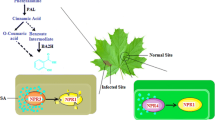Abstract
The hypothesis that physiologically activeconcentrations of salicylic acid (SA) and itsderivatives can confer stress tolerance in plants wasevaluated using bean (Phaseolus vulgaris L.) andtomato (Lycopersicon esculentum L.). Plantsgrown from seeds imbibed in aqueous solutions (0.1--0.5 mM) of salicylic acid or acetyl salicylic acid(ASA) displayed enhanced tolerance to heat, chillingand drought stresses. Seedlings acquired similarstress tolerance when SA or ASA treatments wereapplied as soil drenches. The fact that seedimbibition with SA or ASA confers stress tolerance inplants is more consistent with a signaling role ofthese molecules, leading to the expression oftolerance rather than a direct effect. Induction ofmultiple stress tolerance in plants by exogenousapplication of SA and its derivatives may have asignificant practical application in agriculture,horticulture and forestry.
Similar content being viewed by others
References
Benson EE (1990) Free radical damage in stored plant germplasm. International board for plant genetic resources. Rome.
Bi Y-M, Kenton P, Murr L, Darby R and Draper J (1995) H2O2 does not function downstream of salicylic acid in the induction of PR protein expression. Plant J 8: 235-245
Chen Z, Silva H and Klesig RF (1993) Active oxygen species in the induction of plant systemic acquired resistance by SA. Science 262: 1883-1886
Cheng IF, Zhao CP, Amolins A, Galazka M and Doneski L (1996) A hypothesis for the in vivo antioxidant activity of salicylic acid. Biometals 9: 285-290
Conrath U, Chen Z, Rizigliano JR and Klessig DF (1995) Two inducers of plant defence responses, 2, 6-dichloroisonicotinic acid and salicylic acid inhibit catalase activity in tobacco. USA: Proc Natl. Acad. Sci. 92: 7143-7147
Dat JF, Foyer CH and Scott IM (1998) Changes in salicylic acid and antioxidants during induced thermotolerance in mustard seedlings. Plant Physiol 118: 1455-1461
Dat JF, Lopez-Delgado H, Foyer CH and Scott IM (1998) Parallel changes in H2O2 and catalase during thermotolerance induced by salicylic acid and heat acclimation of mustard seedlings. Plant Physiol 116: 1351-1357
Enyedi AJ, Yalpani N, Silverman P and Raskin I (1992) Signal molecules in systemic plant resistance to pathogens and pests. Cell 70: 879-886
Fletcher RA and Hofstra G (1988) Triazoles as potential plant protectants. In: Berg D and Plempel M (eds) Sterol Biosynthesis Inhibitors: Pharmaceutical and Agricultural Aspects. Cambridge: Ellis Horwood Ltd., pp. 321-331
Keppler LD and Novasky A (1987) The initiation of membrane lipid peroxidation during bacteria-induced hypersensitive reaction. Physiol. Molec. Plant Path. 30: 233-245
Klessig DF and Malamy J (1994) The salicylic acid signal in plants. Plant Molec. Biol. 26: 1439-1458
Kraus TE and Fletcher RA (1994) Paclobutrazol protects wheat seedlings from heat and paraquat injury. Is detoxification of active oxygen species involved? Plant Cell Physiol. 35: 45-52
Levin A, Teneken R, Dixon RA and Lamb CJ (1994) H2O2 from the oxidative burst orchestrates the plant hypersensitive disease resistance response. Cell 79: 583-593
Lopez-Delgado H, Dat JF, Foyer CH and Scott IM (1998) Induction of thermotolerance in potato microplants by acetylsalicylic acid and H2O2. J Exp Bot 49: 713-720
McKersie BD, Senaratna T, Walker MA, Kendall EJ and Hetherington PR (1988) Deterioration of membranes during aging 161 in plants: Evidence for free radical mediation. In: Nooden LD and Leopold AC (eds) Senescence and aging in plants. London: Academic press, pp. 442-464
Mehdy MC (1994) Active oxygen species in plant defence against pathogens. Plant Physiol. 105: 467-472
Mur LAJ, Naylor G, Warner SAJ, Sugars JM, White RF and Draper J (1996) Salicylic acid potentiates defence gene expression in leaf tissues exhibiting acquired resistance to pathogen attack. Plant J. 9: 559-571
Neuenschwander U, Vernooij B, Friedrich L, Uknes S, Kessmann H and Ryals J (1995) Is hydrogen peroxide a second messenger of salicylic acid in systemic acquired resistance. Plant J. 8: 227-233
Raskin I (1992) Role of salicylic acid in plants. Ann. Rev. Plant Physiol. Molec. Biol. 43: 439-463
Ryals JA, Neuenschwander UH, Willits mg, Molina A, Steiner HY and Hunt MD (1996) Systemic acquired resistance. Plant Cell 8: 1809-1819
Senaratna T, McKay CE, McKersie BD and Fletcher RA (1988) Uniconazole induced chilling tolerance in tomato and its relationship to antioxidant content. J. Plant Physiol. 133: 56-61
Senaratna T, McKersie BD and Borochov A (1987) Desiccation and free radical mediated changes in plant membranes. J. Exp. Bot. 38: 2005-2014
Senaratna T, McKersie BD and Stinson RH (1985) Simulation of dehydration injury by free radicals. Plant Physiol. 77: 472-474
Senaratna T, McKersie BD and Stinson RH (1985) Antioxidant levels in germinating soybean seed axes in relation to free radical and dehydration tolerance. Plant Physiol. 78: 168-171
Shirasu K, Nakajima H, Rajasekar VK, Dixon RA and Lamb C (1997) Salicylic acid potentiates an agonist-dependent gain control that amplifies pathogen signal in the activation of defence mechanisms. The Plant Cell 9: 261-270
Srivastava MK and Dwivedi UN (1998) Salicylic acid modulates glutathione metabolism in pea seedlings. J. Plant Physiol. 153: 404-409
Sun WQ, Irving TC and Leopold AC (1994) The role of sugar, vitrification and membrane phase transition in seed desiccation tolerance. Physiol. Plant. 90: 621-628
Author information
Authors and Affiliations
Corresponding author
Rights and permissions
About this article
Cite this article
Senaratna, T., Touchell, D., Bunn, E. et al. Acetyl salicylic acid (Aspirin) and salicylic acid induce multiple stress tolerance in bean and tomato plants. Plant Growth Regulation 30, 157–161 (2000). https://doi.org/10.1023/A:1006386800974
Issue Date:
DOI: https://doi.org/10.1023/A:1006386800974




